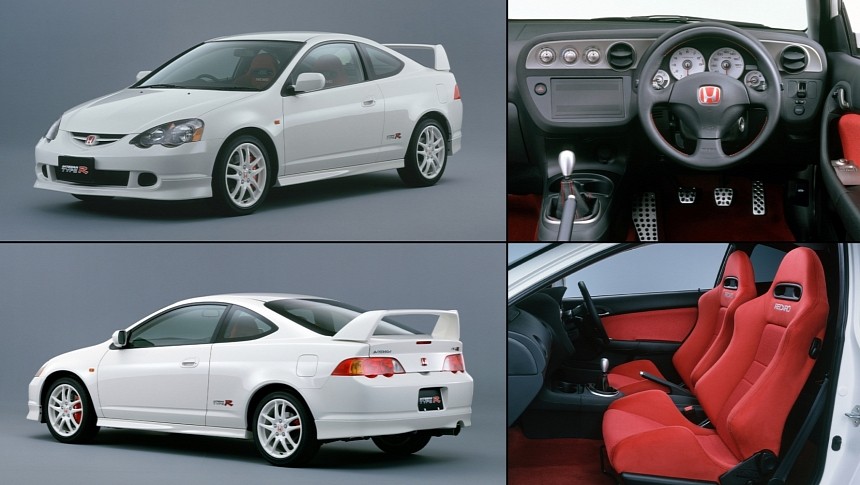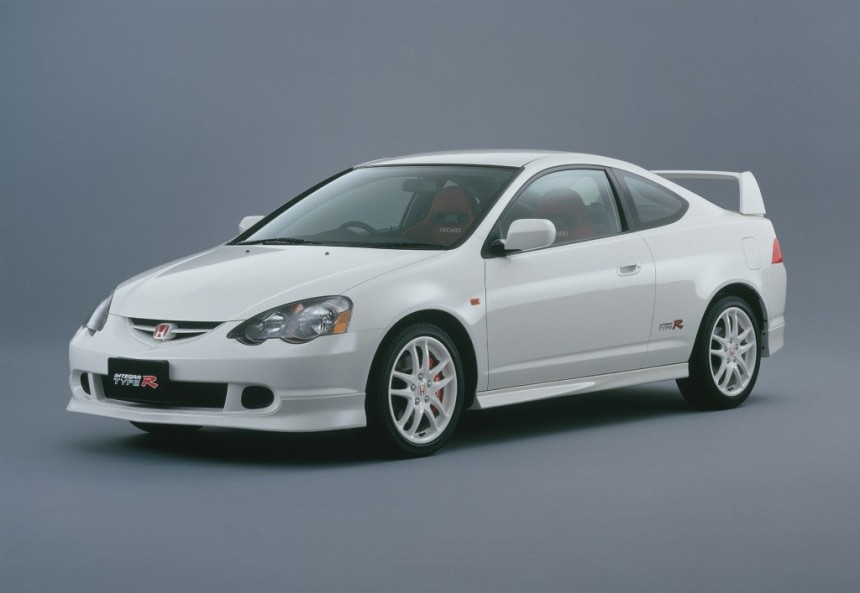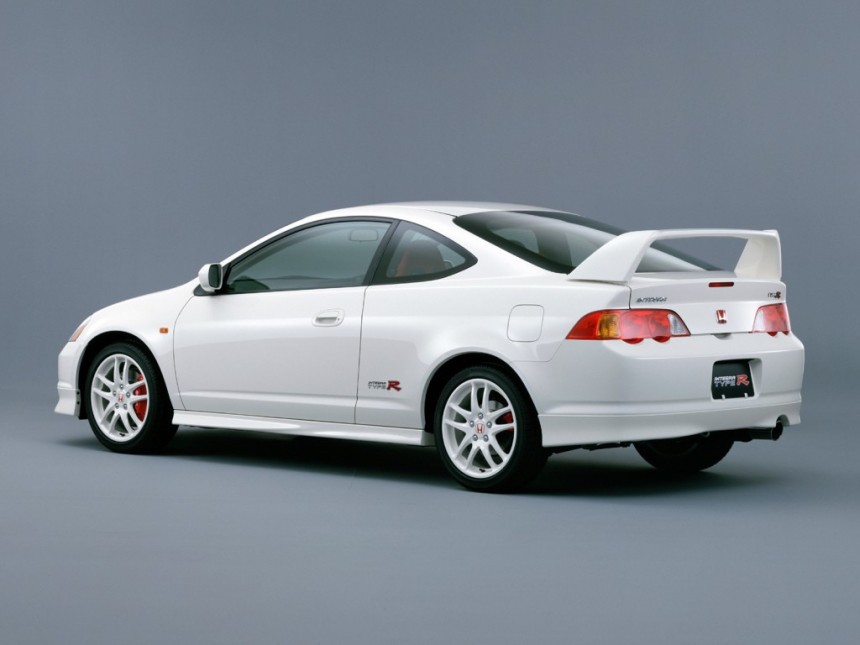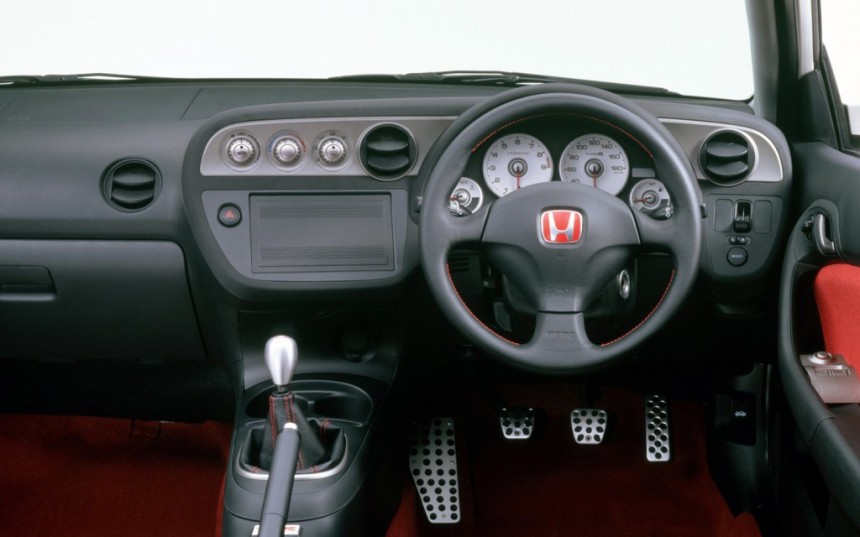The R designation was born nearly three decades ago, in 1992, with the introduction of the NSX Type R. Only 483 units were produced through 1995. Next up, Honda rolled out the DC2 Integra Type R and more practical DB8 Integra Type R. The ITRs proved commercially successful at home and outside Japan, for both are genuinely fun driving machines that used to retail at a fraction of the price of the mid-engine supercar.
Honda understood that R derivatives of more affordable cars make a lot of sense. Building on the popularity of the ITR, the CTR followed suit in 1997. The ATR of 1998 was exclusive to European markets, with its JDM sibling dubbed Accord Euro-R. Come 2001, the redesigned Civic and Integra both received new Type R versions. The EP3 is by far the more popular of the two with European car enthsuiasts, partly because it was made in the United Kingdom. The DC5 generation, however, was far more important for both Honda and the Honda Type R lineage.
Even though it's not as iconic as the DC2, the DC5 was developed concomitantly with lesser variants of the fourth-generation Integra. Be that as it may, the suspension geometry isn't as easy to set up as that of the DC2. It's a well-known fact that lowering the DC5 will make the front wheels toe in. A simple alignment won't fix this condition. On the upside, the second coming of the Integra Type R is decidedly better in the twisties. The addition of a sixth forward gear also makes it superior in a straight line, thus dropping the highway RPMs.
More upmarket than the EP3 Civic Type R mentioned earlier, the DC5 Integra Type R is more desirable to boot, partly due to its three-door coupe body style. As opposed to the DC2-derived DB8, the DC5 was never offered as a four-door sedan. Publicly unveiled in October 2001 at the Tokyo Motor Show, the all-new ITR didn't come to the United States market. Over in North America, the closest thing to it was the Acura RSX Type S with the 200-horsepower K20A2 four-pot mill. Honda used this lump for the Australia- and New Zealand-specific DC5 ITR.
Assembled exclusively at the Suzuka plant in the Mie Prefecture of Japan, the DC5 entered production for the 2002 model year. It was exclusively right-hand drive, but alas, the United Kingdom didn't receive it because of the locally-produced EP3. As such, the DC5 was limited to the Land of the Rising Sun, the Oz, as well as neighboring New Zealand.
In the suck-squeeze-bang-blow department, the Integra Type R was upgraded from the 1.8-liter B18C Type R of the DC2 to the 2.0-liter K20A High Performance. The actual displacement is 1,998 cubic centimeters, with bore and stroke measuring 86 millimeters both. Surprisingly lighter than the B18 of the DC2, the K20A High Performance of the DC5 is more powerful and torquier compared to the K20A High Performance in the Civic Type R of that era. The Integra Type R also revs higher than the EP3. On full song, it belts out 217 horsepower at 8,000 revolutions per minute and 152 pound-feet (206 Nm) at 7,000 revolutions per minute. This i-VTEC engineering masterpiece cuts off the fuel at a screaming 8,600 revolutions per minute.
Intelligent VTEC activates at 6,000 revolutions per minute. PGM-FI electronic multi-point fuel injection, coil-on-plug ignition, roller rockers, and hollow camshafts are featured. The compression ratio is also higher than the B18C Type R, namely 11.5:1 as opposed to 11.1:1 for the DC2 and DB8. The close-ratio manual transmission may feature an extra forward ratio compared to the five-speed unit of the previous generation, yet it's 2.5 kilos (5.5 pounds) lighter and 20 millimeters shorter.
A forged chromoly flywheel improved throttle response and acceleration over the five-speed manual of the DC2 and DB8. The gearbox of the DC5 further stands out in the crowd for employing multiple synchromesh cones across the board. First and second are triple-cone affairs, whereas third to sixth gear boast double-cone synchronizers. From the standpoint of chassis and suspension technologies, we're dealing with double wishbones for the rear end, MacPherson struts up front, a front strut brake, a beefy anti-roll bar out back, plus aluminum lower control arms.
Built around a steel unibody, the DC5 is noticeably stiffer than its critically acclaimed predecessor in terms of torsional rigidity. Due to its larger dimensions, the DC5 is understandably heavier than the DC2. Be that as it may, Honda went to great lengths to make it as light as technically possible, even removing the sound deadening.
AU and NZ cars weigh 1,160 kilograms (2,557 pounds), but over in Japan, the JDM specification is estimated at 1,170 kilograms (2,579 pounds). Air conditioning adds 10 kilograms (22 pounds) to the tally. Oceania cars originally featured the Bridgestone Potenza RE030, whereas Japanese cars were offered with either RE040s or Yokohama A046 rubber. Tire dimensions varied between 205/55 x 16 inches and 215/45 x 17 inches.
Recaro buckets came standard, as did a three-spoke MOMO steering wheel. Red stitching, an aluminum shift knob, drilled aluminum pedals and footrest, and either black or red carpets also need to be highlighted, as well as three colors for the upholstery on the door panels and seats. Those colors being the Type R-specific red, black, or blue. In regard to extras, the list includes a stereo, an immobilizer/alarm system, and something called the C Package. The latter comprised privacy glass for the rear quarters, electric folding mirrors, and a rear wiper.
Honda updated the DC5 in the fall of 2003 for model year 2004 with body-color washer nozzles on the hood. The 2005 refresh is easier to identify thanks to the cleaner-looking headlights, new grille, and titanium inserts for the interior. The Japanese manufacturer also sweetened the deal with a larger brake master cylinder, a revised steering rack, and suspension enhancements (think uprated bushes, springs, and dampers).
The second, and probably the last-ever Integra Type R, ended series production in early summer 2005. Between 2,000 and 3,000 units were delivered to Australia and New Zealand, all of them featuring less power and torque due to the lower compression ratio (11.0:1) and lesser intake manifold (PRB instead of PRC) of the K20A2 engine. These vehicles are fairly easy to tell apart from their JDM equivalents due to the lack of Brembo front brakes and the 1.0-inch smaller wheels. Series production for the Japanese domestic market came to a screeching halt after the 12,247th example rolled off the line.
Even though it's not as iconic as the DC2, the DC5 was developed concomitantly with lesser variants of the fourth-generation Integra. Be that as it may, the suspension geometry isn't as easy to set up as that of the DC2. It's a well-known fact that lowering the DC5 will make the front wheels toe in. A simple alignment won't fix this condition. On the upside, the second coming of the Integra Type R is decidedly better in the twisties. The addition of a sixth forward gear also makes it superior in a straight line, thus dropping the highway RPMs.
More upmarket than the EP3 Civic Type R mentioned earlier, the DC5 Integra Type R is more desirable to boot, partly due to its three-door coupe body style. As opposed to the DC2-derived DB8, the DC5 was never offered as a four-door sedan. Publicly unveiled in October 2001 at the Tokyo Motor Show, the all-new ITR didn't come to the United States market. Over in North America, the closest thing to it was the Acura RSX Type S with the 200-horsepower K20A2 four-pot mill. Honda used this lump for the Australia- and New Zealand-specific DC5 ITR.
In the suck-squeeze-bang-blow department, the Integra Type R was upgraded from the 1.8-liter B18C Type R of the DC2 to the 2.0-liter K20A High Performance. The actual displacement is 1,998 cubic centimeters, with bore and stroke measuring 86 millimeters both. Surprisingly lighter than the B18 of the DC2, the K20A High Performance of the DC5 is more powerful and torquier compared to the K20A High Performance in the Civic Type R of that era. The Integra Type R also revs higher than the EP3. On full song, it belts out 217 horsepower at 8,000 revolutions per minute and 152 pound-feet (206 Nm) at 7,000 revolutions per minute. This i-VTEC engineering masterpiece cuts off the fuel at a screaming 8,600 revolutions per minute.
Intelligent VTEC activates at 6,000 revolutions per minute. PGM-FI electronic multi-point fuel injection, coil-on-plug ignition, roller rockers, and hollow camshafts are featured. The compression ratio is also higher than the B18C Type R, namely 11.5:1 as opposed to 11.1:1 for the DC2 and DB8. The close-ratio manual transmission may feature an extra forward ratio compared to the five-speed unit of the previous generation, yet it's 2.5 kilos (5.5 pounds) lighter and 20 millimeters shorter.
Built around a steel unibody, the DC5 is noticeably stiffer than its critically acclaimed predecessor in terms of torsional rigidity. Due to its larger dimensions, the DC5 is understandably heavier than the DC2. Be that as it may, Honda went to great lengths to make it as light as technically possible, even removing the sound deadening.
AU and NZ cars weigh 1,160 kilograms (2,557 pounds), but over in Japan, the JDM specification is estimated at 1,170 kilograms (2,579 pounds). Air conditioning adds 10 kilograms (22 pounds) to the tally. Oceania cars originally featured the Bridgestone Potenza RE030, whereas Japanese cars were offered with either RE040s or Yokohama A046 rubber. Tire dimensions varied between 205/55 x 16 inches and 215/45 x 17 inches.
Honda updated the DC5 in the fall of 2003 for model year 2004 with body-color washer nozzles on the hood. The 2005 refresh is easier to identify thanks to the cleaner-looking headlights, new grille, and titanium inserts for the interior. The Japanese manufacturer also sweetened the deal with a larger brake master cylinder, a revised steering rack, and suspension enhancements (think uprated bushes, springs, and dampers).
The second, and probably the last-ever Integra Type R, ended series production in early summer 2005. Between 2,000 and 3,000 units were delivered to Australia and New Zealand, all of them featuring less power and torque due to the lower compression ratio (11.0:1) and lesser intake manifold (PRB instead of PRC) of the K20A2 engine. These vehicles are fairly easy to tell apart from their JDM equivalents due to the lack of Brembo front brakes and the 1.0-inch smaller wheels. Series production for the Japanese domestic market came to a screeching halt after the 12,247th example rolled off the line.












